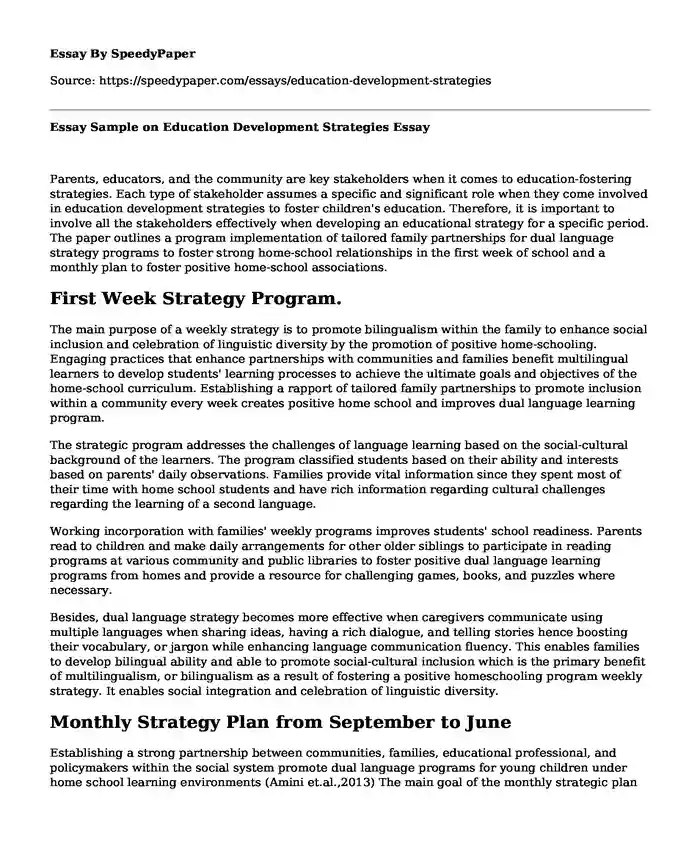
| Type of paper: | Course work |
| Categories: | Learning School Family Community |
| Pages: | 3 |
| Wordcount: | 637 words |
Parents, educators, and the community are key stakeholders when it comes to education-fostering strategies. Each type of stakeholder assumes a specific and significant role when they come involved in education development strategies to foster children's education. Therefore, it is important to involve all the stakeholders effectively when developing an educational strategy for a specific period. The paper outlines a program implementation of tailored family partnerships for dual language strategy programs to foster strong home-school relationships in the first week of school and a monthly plan to foster positive home-school associations.
First Week Strategy Program.
The main purpose of a weekly strategy is to promote bilingualism within the family to enhance social inclusion and celebration of linguistic diversity by the promotion of positive home-schooling. Engaging practices that enhance partnerships with communities and families benefit multilingual learners to develop students' learning processes to achieve the ultimate goals and objectives of the home-school curriculum. Establishing a rapport of tailored family partnerships to promote inclusion within a community every week creates positive home school and improves dual language learning program.
The strategic program addresses the challenges of language learning based on the social-cultural background of the learners. The program classified students based on their ability and interests based on parents' daily observations. Families provide vital information since they spent most of their time with home school students and have rich information regarding cultural challenges regarding the learning of a second language.
Working incorporation with families' weekly programs improves students' school readiness. Parents read to children and make daily arrangements for other older siblings to participate in reading programs at various community and public libraries to foster positive dual language learning programs from homes and provide a resource for challenging games, books, and puzzles where necessary.
Besides, dual language strategy becomes more effective when caregivers communicate using multiple languages when sharing ideas, having a rich dialogue, and telling stories hence boosting their vocabulary, or jargon while enhancing language communication fluency. This enables families to develop bilingual ability and able to promote social-cultural inclusion which is the primary benefit of multilingualism, or bilingualism as a result of fostering a positive homeschooling program weekly strategy. It enables social integration and celebration of linguistic diversity.
Monthly Strategy Plan from September to June
Establishing a strong partnership between communities, families, educational professional, and policymakers within the social system promote dual language programs for young children under home school learning environments (Amini et.al.,2013) The main goal of the monthly strategic plan to foster home school learners to develop language literacy. The approach takes several significant steps to promote and support communities to cultivate strong home dual langue environments.
Building a relationship with the family. To implement the program, professional educators will have to encourage and promote specific language-building activities. Productive and positive relationships are the most fundamental step to promoting the dual language to encourage the process of homeschooling and building family, and community relationships. It is achieved by connecting them with professional educators and conducting home visits to evaluate learning processes.
Encourage families to read and sharing of kid's progress. The primary task of the educators will be encouraging families to allow their children to read, play and talk in different languages under the home school learning curriculum. The educators will also share children's progress continuously to make sure if the families understand and promote the learner's literacy.
In conclusion, fostering two-way channels of communication. Community and family provide rich information which is essential for strong and supportive home school environments for learning. Besides, they provide an educational professional with insights concerning children's needs, challenges, and areas they feel comfortable.
References
Amini Virmani, E., Masyn, K. E., Thompson, R. A., ConnersBurrow, N. A., & Whiteside Mansell, L. (2013). Early childhood mental health consultation: Promoting change in the quality of teacher-child interactions. Infant Mental Health Journal, 34(2), 156-172.
Cite this page
Essay Sample on Education Development Strategies. (2023, Mar 29). Retrieved from https://speedypaper.com/essays/education-development-strategies
Request Removal
If you are the original author of this essay and no longer wish to have it published on the SpeedyPaper website, please click below to request its removal:
- Free Essay about the Effects of Childhood Obesity in America
- Free Essay on Engagement and Assessment of Communities
- Rhetorical Analysis Essay on the Violence in Mass Media Article, Free Example
- Discussion Essay Example on Deductive and Inductive Arguments
- Encore Album by Eminem
- Essay Example: Human Trafficking of Women in Nigeria
- Racism in the Adventures of Huckleberry Finn. Free Essay
Popular categories




